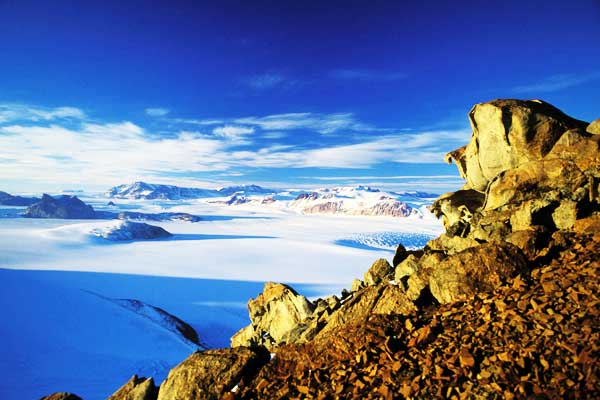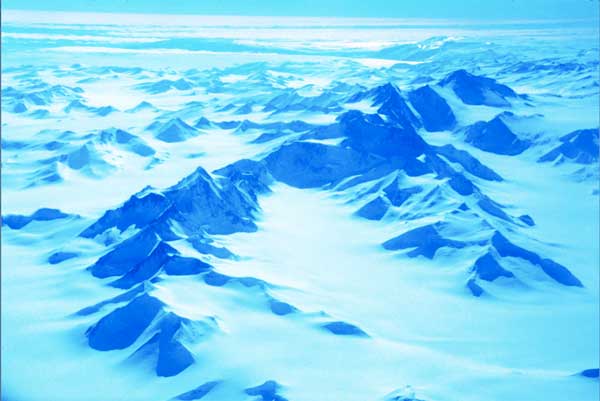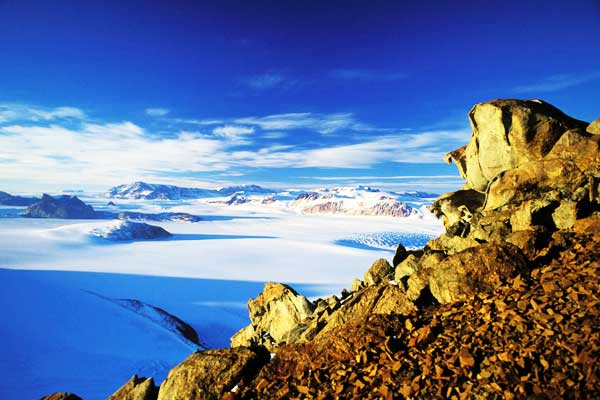The Transantarctic Mountains are an enormous mountain range in Antarctica that divide the continent into East Antarctica and West Antarctica. The range spans across the continent, beginning at Cape Adare and ending around Coats Land.
The mountains were first discovered in 1841 by James Clark Ross at the Ross Ice Shelf and were first crossed by the British National Antarctic Expedition between 1901 and 1904.
Have a look through this guide for a complete overview on the Transantarctic Mountains, including their geology, climate and notable mountains in the range.
See our guides page to compare it to other ranges in the world.
Transantarctic Mountain Range
Width: 100-300 km
Length: 3,550km
Physical Geography
Geology
The Transantarctic Mountains are some of the oldest mountains in Antarctica. They were formed approximately 65 million years ago during the Cenozoic period when the West Antarctic Rift opened and continental crust was forced to uplift.
The range consists of many sedimentary layers which lie on top of a basement, or core, of granite and gneiss rocks.
The subranges of the Transantarctic Mountains are defined through multiple perpendicular outlet glaciers, which allow ice from the East Antarctic Ice Sheet to flow through the mountains and out into the Ross Sea, the Ross Ice Shelf and the West Antarctic Ice Sheet.
Topography
The Transantarctic Mountains span across Antarctica, dividing it into its two halves: West Antarctica and East Antarctica. The range has a length of 3,500 km, which makes it one of the longest mountain ranges in the world.
The eastern side of the Transantarctic Mountains is bounded by the East Antarctic Ice Sheet, while the western side is bordered by the West Antarctic Ice Sheet, the Ross Ice Shelf and the Ross Sea in Victoria Land.
Climate
The climate of the Transantarctic Mountain Range is extremely cold as Antarctica has the coldest recorded temperatures and is the coldest continent in the world. Average daily temperatures in the mountains range from -34˚F to -22˚F (-37˚C to -30˚C) in the winter and -5˚F to -1˚F(-21˚C to -17˚C) in the summer months.
The western side of the Transantarctic Mountains has a much warmer climate with temperatures rarely falling below 14˚F (-10˚C) and summer averages exceeding 32˚F (0˚C).
The best time for climbing in the mountain range is from December to February as they are the warmest months of the year. This is the summer time in Antarctica where the sun shines for all 24 hours of the day.
Wildlife and Plants
Due to the cold climate of Antarctica, there is very little vegetation and very few species of wildlife that live on the continent. Vegetation in the Transantarctic Mountains consists of lichen, fungi, algae and bacteria.
Several animal species can be found living around the coastline of the Ross Sea in Victoria Land on the western side of the Transantarctic Mountains. These include various penguin species, seals and sea birds.
Regions In Transantarctic Mountains
Victoria Land

Victoria Land is a region in Antarctica that contains some of the mountain ranges that make up the Transantarctic Mountains. These ranges include the Concord Mountains, Admiralty Mountains, Victory Mountains and the Prince Albert Mountains.
Central Transantarctic Mountains

The Central Transantarctic Mountains is the region of the Transantarctic Mountains that consists of the Queen Alexandra Range as well as several major glaciers, including the Mulock Glacier, Byrd Glacier, Nimrod Glacier and the Beardmore Glacier.
The Queen Alexandra Range is one of the main mountain ranges that makes up the Transantarctic Mountains and is situated in the Ross Dependency region of Antarctica.
The range is approximately 160km long and contains the highest peak in the Transantarctic Mountains, Mount Kirkpatrick at an elevation of 4,528 meters.
Queen Maud Mountains

The Queen Maud Mountains is a large region of the Transantarctic Mountains and is comprised of many different ranges, mountains and features such as glaciers, hills, bluffs and spurs. This region is located between the Beardmore Glacier and the Reedy Glacier, and also includes the area from the top of the Ross Ice Shelf to the Antarctic Plateau.
This enormous group of mountain ranges in the Transantarctic Mountains was named after Maud of Wales, Queen of Norway, but contrary to its name, the region is not located in the Queen Maud Land region of Antarctica.
Some of the main ranges and mountains located in the Queen Maud Mountains are the Barton, Bush, Gothic, Grosvenor, Hays, La Gorce, Prince Olav, Rawson and Tapley Mountains, as well as the Commonwealth, Dominion, Herbert, Hughes, Quarles and Supporters Ranges.
Southern Transantarctic Mountains

The Southern Transantarctic Mountains is the region of the Transantarctic Mountains that spans from the Reedy Glacier all the way to the Theron Mountains near Coats Land where the massive mountain range comes to an end.
This region is comprised of several major ranges and mountain groups, including the Horlick Mountains, Thiel Mountains, Pensacola Mountains, Shackleton Range and the Theron Mountains.
The Pensacola Mountains are one of the larger groups of mountain ranges in the Transantarctic Mountains as it includes the Neptune Range, Forrestal Range, Patuxent Range, Argentina Range, Pecora Escarpment and the Dufek Massif.
Notable Transantarctic Mountains And Peaks
The Transantarctic Mountains are a large and extensive system of mountain ranges that contains many notable mountains and impressive peaks. Here are some of the most notable mountains in the Transantarctic Mountains.
Mount Kirkpatrick
Mount Kirkpatrick is the highest mountain in the Transantarctic Mountains and is located in the Queen Alexandra Range along with the next four highest peaks in the range. It has a height of 4,528 meters and is generally ice-free.
The mountain was named after a Glasgow businessman who was an original supporter of the British Antarctic Expedition (1907-1909).
One of Antarctica's most important fossil sites, the Hanson Formation is located at Mount Kirkpatrick. Various dinosaur fossils, including the Cryolophosaurus and the Glacialisaurus hammeri have been found and excavated from this site.Mount Elizabeth
Mount Elizabeth is the second highest mountain in the Transantarctic Mountains with an elevation of 4,480 meters above sea level. It is also located in the Queen Alexandra Range.
The British Antarctic Expedition discovered Mount Elizabeth and named the large, ice-free mountain after Elizabeth Dawson-Lambton who was a supporter of the expedition.
Mount Markham
Mount Markham is a big massif located at the northern end of the Markham Plateau and has two peaks, a main one and a lower, sub-peak. The more prominent peak has an elevation of 4,350 meters, while the smaller one reaches a height 4,280 meters above sea level.
Mount Markham was also discovered by the British Antarctica Expedition and was named after the President of the Royal Geographic Society, Sir Clements Markham, who planned the expedition and appointed Robert Falcon Scott to be its leader.
Mount Bell
Mount Bell has an elevation of 4,305 meters and forms part of the Grindley Plateau in the Queen Alexandra Range of the Transantarctic Mountains. The mountain was named after William Bell, a supporter of the British Antarctic Expedition.
Mount Kaplan
Mount Kaplan is an enormous mountain in the Hughes Range of the Queen Maud Mountains in the Transantarctic Mountains. It has an elevation of 4,230 meters above sea level and stands only 5km from Mount Wexler, a prominent, 4,025 meter tall, ice-free mountain.
Mount Kaplan was discovered in 1929 by Admiral Byrd on the Baselaying Flight. It was surveyed from 1957 to 1958 by A.P. Crary who named it after the chairman of the U.S. National Committee for the International Geophysical Year, Joseph Kaplan.
Hiking in the Transantarctic Range
The Transantarctic Mountains pose daunting and remote challenges for avid mountaineers as it is comprised of many different mountains, hills, domes, glaciers and bluffs, some of which are ice-free while.
Climbing mountains in Antarctica takes a lot of planning as it is such an isolated continent with an extremely cold and harsh climate. Many of the mountains in the range have never been climbed because of the costliness of mountaineering expeditions in Antarctica.
Mountaineering in Antarctica is also very dangerous due to its isolation, extreme weather and lack of medical facilities.
Most mountaineering is done for scientific research so any recreational climbing requires a lot of organising and logistical planning. However, any climbers with the means to go mountaineering in Antarctica will have a truly unique and special experience.
Mount Markham Climb
Mount Markham is the third highest peak in the Transantarctic Mountains at 4,350 meters. Its summit can be reached by helicopter or by climbing the massive massif one step at a time.
Three of its four sides are covered with ridges so an approach from the south side is the best route for climbers.
Mount Herschel Climb
Mount Herschel is an imposing peak in the Admiralty Mountains in the Victoria Land region of the Transantarctic Mountains. Its summit has an elevation of 3,335 meters and requires a high level of technical skill and rope work to reach via its north ridge.
References: Britannica, NASA, Wikipedia
Also see: Sentinel range

